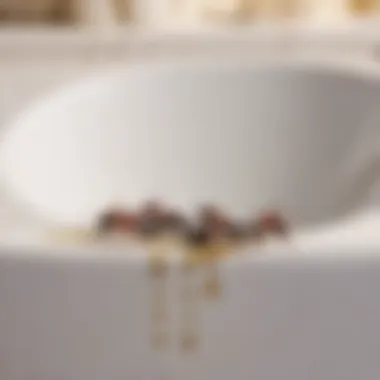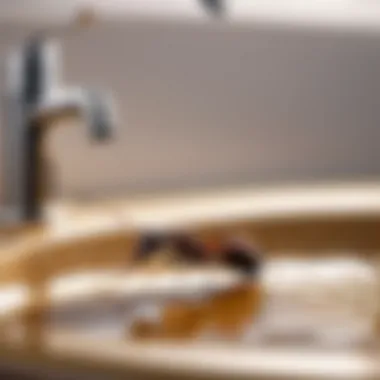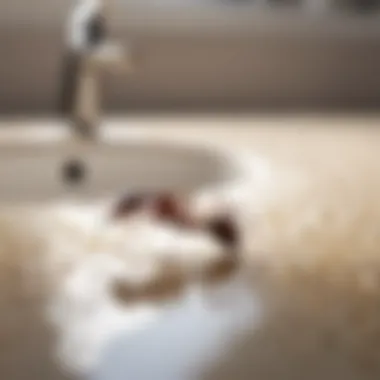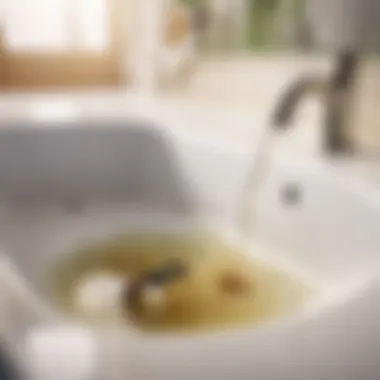Effective Strategies to Eliminate Ants in Bathroom Sink Drains


Materials:
- Vacuum cleaner
- Ant bait gel
- Sealant
- Boiling water
- Cleaning brush
DIY Steps:
- Identify the Infestation: Check for signs of ants in your bathroom sink drain such as ants emerging from the drain or visible trails of ants.
- Thorough Cleaning: Use a vacuum cleaner to remove any visible ants and debris from the sink area.
- Apply Ant Bait Gel: Place ant bait gel near the drain entrance to attract and eliminate ants effectively.
- Seal Any Entry Points: Use sealant to close off any gaps or cracks where ants may be entering the bathroom.
- Flush with Boiling Water: Pour boiling water down the drain to kill remaining ants and disrupt their pheromone trails.
- Regular Maintenance: Keep the sink area clean and dry to prevent future ant infestations.
Technical Aspects:
- Tools Required: Vacuum cleaner, cleaning brush, sealant applicator
- Timing: Approximately 30-60 minutes to complete the ant removal process
- Critical Techniques: Ensuring thorough cleaning and proper application of ant bait gel for maximum effectiveness
DIY Project Process:
- Preparation: Gather all materials and tools required for the task
- Identification: Locate the source of the ant infestation in the bathroom sink drain
- Treatment: Follow the steps outlined above to eradicate the ants
- Prevention: Maintain cleanliness and address any potential entry points to deter future infestations
Troubleshooting Tips:
- If ants persist after treatment, consider seeking professional pest control assistance
- Ensure proper disposal of ant-infested debris to prevent reinfestation
Understanding Ant Behavior
Understanding the behavior of ants is crucial when tackling the issue of infestations in bathroom sink drains. By delving into the intricacies of ant behavior, individuals can grasp why these pests are drawn to specific environments and how they operate within colonies. Ant behavior encompasses a vast array of actions, from foraging for food to communicating through pheromones. This section aims to provide a comprehensive overview of how ants behave and interact, shedding light on their biology and instincts.


Ant Colonies and Foraging Patterns
How Ant Colonies Function
Ant colonies serve as intricate systems where each member plays a vital role in the survival and propagation of the group. Understanding how ant colonies function is essential for comprehending their foraging patterns and overall behavior. Ant colonies typically consist of a queen, workers, and sometimes soldiers, each with specific duties that contribute to the colony's success. The queen's primary task is to reproduce, ensuring the continuation of the colony, while workers gather food, care for the young, and defend the nest. This division of labor within ant colonies helps streamline activities, maximizing efficiency and ensuring the colony's sustainability.
Foraging Behavior of Ants
Ants exhibit fascinating foraging behavior, where they search for food to sustain the colony. The foraging process involves intricate communication methods, such as pheromone trails laid down by scout ants to guide others to food sources. Understanding how ants forage and navigate their environment sheds light on their resourcefulness and adaptability. Ants can detect different food types, communicate effectively with nestmates, and establish efficient foraging routes. This behavior allows ants to maximize food intake while minimizing risks, showcasing their ability to thrive in various environments.
Attraction to Moist Environments
Ants are inherently attracted to moist environments due to their dependency on water for survival. Moist areas, such as bathroom sink drains, provide ants with hydration and potential food sources, making them attractive habitats for these pests. This section explores why ants seek water sources and the implications of moisture on ant infestations.
Ants Seeking Water Sources
The search for water is a fundamental aspect of ant behavior, as hydration is essential for their physiological functions and nest maintenance. Ants seeking water sources exhibit a keen sense of moisture detection, using their antennae to locate areas with high humidity levels. By pinpointing water reservoirs, ants ensure the survival of their colony and increase their foraging success. Understanding ants' attraction to water sheds light on their persistence in infiltrating areas like bathroom sink drains in pursuit of this vital resource.
Impact of Moisture on Ant Infestations
Moisture plays a significant role in encouraging ant infestations, as it provides ideal conditions for ant survival and reproduction. High levels of moisture create hospitable environments for ants to thrive, leading to accelerated population growth and infestation severity. Furthermore, dampness can attract other insects that serve as additional food sources for ants, exacerbating the infestation. Identifying the correlation between moisture levels and ant infestations is essential for implementing effective control measures and preventing future incursions.
Identification of Ant Species
Common Ant Types Found in Drains


Several common ant species are known to infest sink drains, including sugar ants, pharaoh ants, and carpenter ants. These ant species are attracted to the damp, dark environment of drains, where they can find shelter, food, and a suitable breeding ground. The key characteristic of common ant types found in drains is their propensity to form large colonies and establish intricate foraging trails within plumbing fixtures. While each ant species may exhibit unique behaviors and nesting preferences, they all share a common affinity for moist areas like sink drains. Recognizing the presence of these ant species in drains is crucial for implementing targeted pest control strategies and preventing recurrent infestations.
Recognizing Ant Trails
Ant trails play a vital role in the foraging behavior of ants and can be used to identify infestation patterns within sink drains. By recognizing ant trails, homeowners can trace the pathways taken by ants to and from drains, pinpointing the source of infestations and nesting sites. The key characteristic of recognizing ant trails is their distinctive pheromone scent, which ants use to communicate with one another and guide their movements. By understanding how to identify and track ant trails, individuals can monitor the extent of infestations, assess the effectiveness of eradication methods, and prevent future incursions. Utilizing this knowledge can empower homeowners to take proactive measures against ant infestations and protect their living spaces from unwelcome pests.
Preventive Measures
Maintaining Clean Drains
When it comes to maintaining clean drains, regular cleaning practices emerge as a cornerstone of effective pest management. Regular cleaning practices involve thorough removal of debris, residue, and standing water that may attract ants. By incorporating a routine cleaning regimen for bathroom sink drains, individuals can hinder ant access to food sources and nesting sites. The consistent implementation of regular cleaning practices fosters a environment that is inhospitable to ants, minimizing the likelihood of infestations.
Regular Cleaning Practices
The essence of regular cleaning practices lies in their ability to prevent the accumulation of organic matter and moisture, which are prime attractants for ants. By regularly flushing drains with hot water, using eco-friendly cleaning agents, and scrubbing surfaces to remove biofilm, individuals can deter ants from infesting sink drains. The systematic incorporation of regular cleaning practices not only enhances sanitation but also disrupts ant foraging trails, impeding their access to essential resources.
Proper Disposal of Food Waste
Proper disposal of food waste serves as a fundamental aspect of maintaining clean drains and deterring ant infestations. By promptly discarding food scraps, residues, and food particles in sealed trash receptacles, individuals can mitigate the presence of enticing food sources for ants. Adopting proper disposal practices promotes cleanliness and sanitation in kitchens and bathrooms, reducing the likelihood of ant attraction. The meticulous disposal of food waste complements regular cleaning practices, creating an unwelcoming environment for ants and other pests.
Addressing Moisture Issues
Addressing moisture issues plays a critical role in preventing ant infestations by eliminating conditions that foster their proliferation. By fixing leaks and dripping faucets, individuals can thwart ants' attraction to areas with high humidity and moisture content. Additionally, utilizing drain covers helps prevent stagnant water accumulation, reducing the allure of sink drains to ants. Addressing moisture issues not only deters ant activity but also contributes to overall household hygiene and comfort.


Fixing Leaks and Dripping Faucets
The action of fixing leaks and dripping faucets mitigates excess moisture, which is a key factor in attracting ants to bathroom sink drains. By promptly repairing plumbing leaks, individuals can uphold dry conditions that discourage ant infestation. Fixing leaks and dripping faucets not only conserves water but also safeguards against potential structural damage caused by prolonged water exposure. This preventive measure aids in creating an inhospitable environment for ants, preventing them from establishing colonies in damp areas.
Using Drain Covers
Employing drain covers serves as a proactive strategy to prevent residues and debris from accumulating in sink drains, deterring ant infestations. Drain covers act as physical barriers that obstruct ant access to potential food sources and breeding grounds within drains. By installing drain covers, individuals can safeguard against blockages, odors, and pest intrusion, enhancing the overall functionality and cleanliness of bathroom drains. The utilization of drain covers is an effective preventive measure that bolsters hygiene practices and reduces the risk of ant infestations in sink drains.
Eradication Techniques
In this article, the topic of Eradication Techniques holds significant importance, as it provides readers with essential strategies to effectively combat ant infestations in bathroom sink drains. Understanding how to eradicate ants properly is crucial in ensuring a pest-free environment and maintaining overall hygiene within the household. By focusing on specific elements such as environmentally-friendly approaches and long-term effectiveness, this section offers practical solutions for readers to implement.
Home Remedies
Vinegar and Water Solution
The Vinegar and Water Solution stands out as a crucial component in combating ant infestations within sink drains. Its acidity levels make it a potent natural repellent against ants, disrupting their pheromone trails and deterring further infestation. This particular remedy is highly effective, affordable, and environmentally friendly, making it a preferred choice for many households dealing with ant issues. The unique feature of the Vinegar and Water Solution lies in its dual functionality as a cleaning agent and pest repellent, providing a holistic approach to addressing ant problems. While its advantages include safety for pets and humans, its main disadvantage may be its strong smell, which dissipates over time.
Baking Soda and Vinegar
When it comes to eradicating ants from bathroom sink drains, the Baking Soda and Vinegar mixture emerges as a versatile and effective solution. The key characteristic of this remedy is its foaming action, which helps dislodge debris, eliminate odors, and suffocate ants present in the drain. The Baking Soda and Vinegar mixture is a popular choice for its ability to dissolve organic matter and sanitize the drain, promoting long-term cleanliness and discouraging ant activity. Its unique feature lies in its dual-action approach to both cleaning and pest control, providing a comprehensive solution for households. While its advantages include natural ingredients and affordability, users should be cautious when handling the mixture to avoid skin irritation.
Professional Pest Control
Seeking Expert Help
Engaging professional pest control services is a crucial aspect of effectively addressing ant infestations in bathroom sink drains. Seeking Expert Help ensures that the infestation is thoroughly assessed and treated using specialized knowledge and techniques. The key characteristic of professional pest control lies in its targeted approach, tailored to the specific ant species and extent of infestation, guaranteeing effective results. This option is beneficial for households dealing with persistent ant problems or large-scale infestations, providing a reliable and efficient solution. The unique feature of Seeking Expert Help is the access to advanced equipment and expertise, ensuring complete eradication of ants from the premises. While its advantages include expertise and guaranteed results, the main disadvantage may be the cost associated with professional services.
Chemical Treatments
Chemical Treatments play a vital role in eradicating ants from bathroom sink drains, offering fast-acting and potent solutions to eliminate ant colonies. The key characteristic of chemical treatments is their ability to target ants at their source, penetrating deep into the drain system to eradicate nests and colonies. This option is popular for its immediate effectiveness in eliminating ants and preventing future infestations when used as directed. The unique feature of Chemical Treatments lies in their residual effect, providing long-lasting protection against ants in the treated area. While its advantages include rapid results and convenience, users should follow safety guidelines and precautions to minimize exposure to chemicals and protect the environment.







